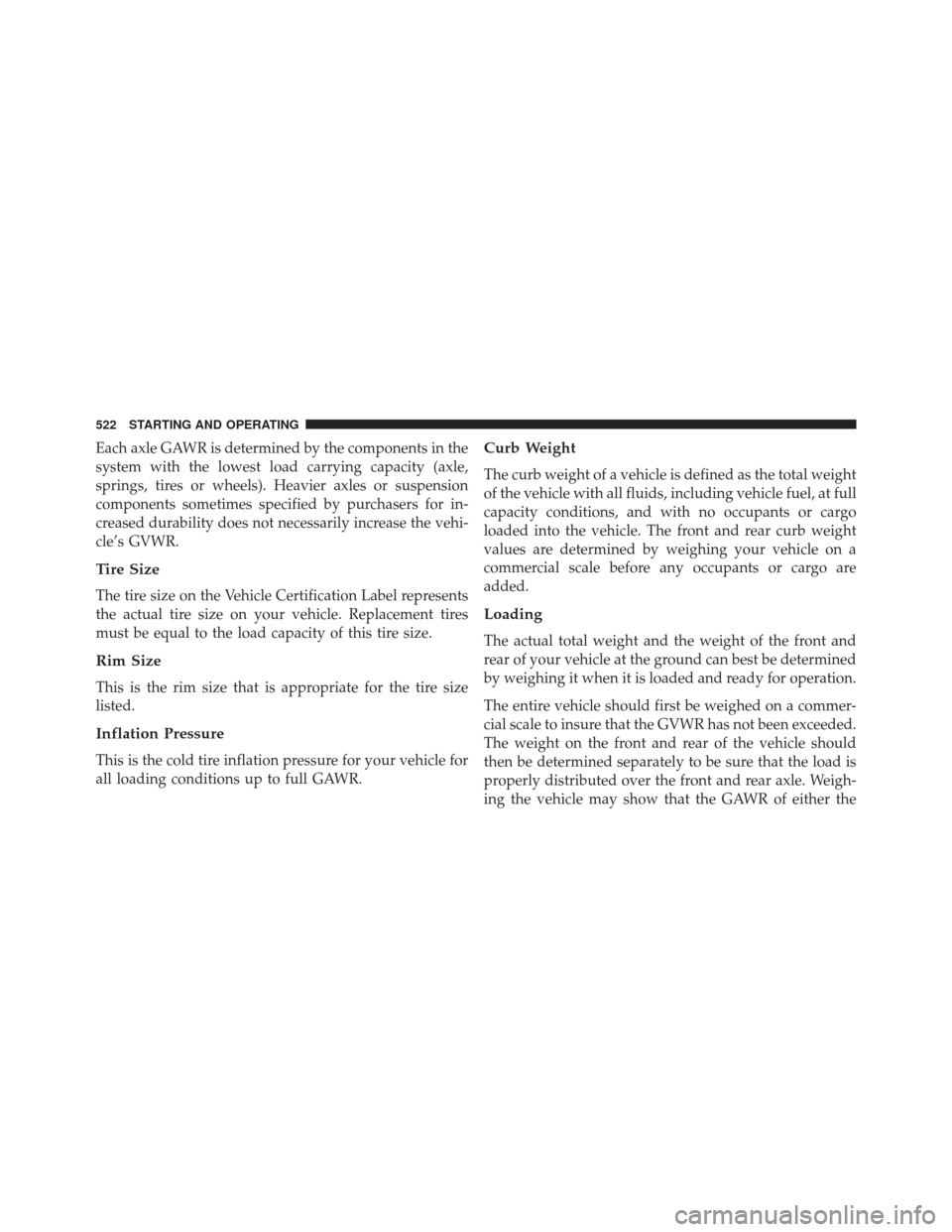Page 509 of 661

For example, your vehicle has a recommended cold
(parked for more than three hours) tire pressure of 33 psi
(227 kPa). If the ambient temperature is 68°F (20°C) and
the measured tire pressure is 28 psi (193 kPa), a tempera-
ture drop to 20°F (-7°C) will decrease the tire pressure to
approximately 24 psi (165 kPa). This tire pressure is
sufficiently low enough to turn ON the Tire Pressure
Monitoring Telltale Light. Driving the vehicle may cause
the tire pressure to rise to approximately 28 psi (193 kPa),
but the Tire Pressure Monitoring Telltale Light will still
be ON. In this situation, the Tire Pressure Monitoring
Telltale Light will turn OFF only after the tires have been
inflated to the vehicle’s recommended cold tire pressure
value.CAUTION!
•The TPMS has been optimized for the original
equipment tires and wheels. TPMS pressures have
been established for the tire size equipped on your
vehicle. Undesirable system operation or sensor
damage may result when using replacement equip-
ment that is not of the same size, type, and/or style.
Aftermarket wheels can cause sensor damage. Do
not use aftermarket tire sealants or balance beads if
your vehicle is equipped with a TPMS, as damage
to the sensors may result.
• After inspecting or adjusting the tire pressure al-
ways reinstall the valve stem cap. This will prevent
moisture and dirt from entering the valve stem,
which could damage the Tire Pressure Monitoring
Sensor.
5
STARTING AND OPERATING 507
Page 524 of 661

Each axle GAWR is determined by the components in the
system with the lowest load carrying capacity (axle,
springs, tires or wheels). Heavier axles or suspension
components sometimes specified by purchasers for in-
creased durability does not necessarily increase the vehi-
cle’s GVWR.
Tire Size
The tire size on the Vehicle Certification Label represents
the actual tire size on your vehicle. Replacement tires
must be equal to the load capacity of this tire size.
Rim Size
This is the rim size that is appropriate for the tire size
listed.
Inflation Pressure
This is the cold tire inflation pressure for your vehicle for
all loading conditions up to full GAWR.
Curb Weight
The curb weight of a vehicle is defined as the total weight
of the vehicle with all fluids, including vehicle fuel, at full
capacity conditions, and with no occupants or cargo
loaded into the vehicle. The front and rear curb weight
values are determined by weighing your vehicle on a
commercial scale before any occupants or cargo are
added.
Loading
The actual total weight and the weight of the front and
rear of your vehicle at the ground can best be determined
by weighing it when it is loaded and ready for operation.
The entire vehicle should first be weighed on a commer-
cial scale to insure that the GVWR has not been exceeded.
The weight on the front and rear of the vehicle should
then be determined separately to be sure that the load is
properly distributed over the front and rear axle. Weigh-
ing the vehicle may show that the GAWR of either the
522 STARTING AND OPERATING
Page 657 of 661

Inflation Pressures..................... .495
Life of Tires .......................... .502
Load Capacity ........................ .489
Pressure Monitor System (TPMS) ...........505
Pressure Warning Light ..................318
Quality Grading ...................... .637
Radial .............................. .497
Replacement ......................... .502
Rotation ............................ .504
Safety .............................. .483
Sizes ............................... .485
Spare Tire ........................... .539
Spinning ............................ .500
Tread Wear Indicators ...................501
Tire Safety Information .....................483
Tongue Weight/Trailer Weight ................528
Tow/Haul Indicator Light ...................317
Tow Hooks, Emergency .....................553
Towing ............................... .52324-Hour Towing Assistance
................152
Behind a Motorhome ....................534
Disabled Vehicle ...................... .555
Guide .............................. .527
Recreational ......................... .534
Weight ............................. .527
Towing Assistance ........................ .152
Towing Vehicle Behind a Motorhome ...........534
Traction Control ......................... .474
Trailer Sway Control (TSC) ..................480
Trailer Towing .......................... .523
Cooling System Tips ....................534
Hitches ............................. .526
Minimum Requirements ..................529
Trailer and Tongue Weight ................528
T
railer Towing Guide ...................... .527
Trailer Weight ........................... .527
Transfer Case ........................... .586
Maintenance ......................... .586
10
INDEX 655
Page:
< prev 1-8 9-16 17-24